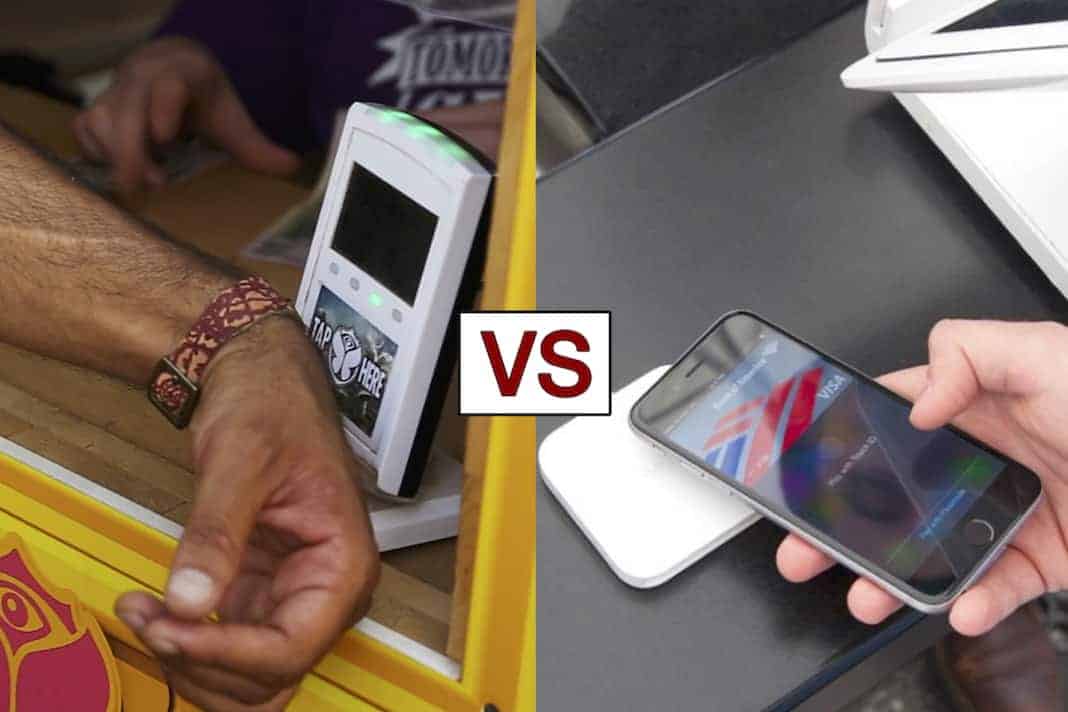There has been a long-standing debate amongst event industry professionals about what type of payment system is better – Closed-Loop or Open-Loop?
The fact of the matter is that there’s no blanket answer due to the live event industry having such a huge range of different types of events within it. Music festivals alone range from small boutique events in a fixed venue on a single day, to the multi-day mega events with hundreds of thousands in attendance.
Trying to blanket the entire industry with one declaration as to which system is best would be a crime, so instead this article will explain:
- Closed-Loop Payments
- Advantages of Closed-Loop
- Disadvantages of Closed-Loop
- Open-Loop Payments
- Advantages of Open-Loop
- Disadvantages of Open-Loop
- Which events should use Open-Loop payments
- Which events should use Closed-Loop payments
What are Closed-Loop payments
A closed loop payments system operates without intermediaries (banks), where end users (event attendees and vendors) instead directly join the payments system.
A real-world example of a Fortune 500 company using a closed-loop payment system is Starbucks. They launched a Mobile Payment and Rewards program that also had features that allowed their customers to place, order and pay for coffee in advance, and then pick it up at nearest location. In order for consumers to use new payment functionality, they had to load money onto their Starbucks Mobile App and use it at the time of checkout for payment processing.
As for the live-event industry the most standard version of a closed-loop payment system is RFID payments systems, the biggest music festival in the world, Tomorrowland, uses a closed-loop payment system to process transactions for its 400,000+ visitors in 2017. They first switched to a closed-loop payment system in 2015 for their original event in Belgium, but also implemented it at their Brazil and Atlanta editions.
(To read all the advantages of closed-loop payments for Tomorrowland and Starbucks please read the “Closed-Loop Advantages”, section further in this article.)
Payments systems must provide three key functions, shown in the figure below: Rules, Brand, and Processing.
Some payments systems provide all three functions through a single organisation. Others accommodate these functions via a virtual, or distributed, model.
- Rules – Bind each of the parties in a system
- In a closed-loop system, the rules bind the end parties directly.
- Brand – How the parties communicate to each other how they will pay
- In a closed-loop system for example, “Please tap your RFID wristband here to pay”. This is how consumers are told the means by which they can pay and how brand awareness around the product is shared.
- Processing (including switching) – How transactions moves from one party to another
- In a closed-loop system, this transfers value between the end parties, which also includes settlement—the process by which the parties involved in a closed-loop system transfer value—usually on a net basis.
Closed-Loop — Advantages
What’s the greatest advantage of a closed-loop payment system?
Simplicity– Since one party sets all the rules, it can act more quickly and more flexibly than the distributed rule setting of open-loop systems.
This is crucial for event organisers when the window of time for transactions is limited to only a few days and 1-minute of delay can cause insurmountable revenue losses.
Closed-loop mobile payments systems can benefit both consumers and vendors alike, which is why many events have not only opted to implement them but have also seen them succeed.
From a merchant perspective, closed-loop payments systems have the following advantages:
- Ability to capture big data on customer transactions, including customer insights, buying habits, popular items, and even return on mobile marketing campaigns
- Minimises internal payment processing which lowers merchant costs
- Increase in customer loyalty through add-on incentive programs
Essentially, proprietary closed-loop systems offer vendors the ability to maintain ownership over the entire vendor/customer process, which open-loop systems can’t provide.
From a live event perspective, closed-loop mobile payments systems make the customer experience with a particular vendor that much more convenient.
A study conducted by American Express found that closed-loop transactions are 53% faster than traditional transactions. With speed and convenience being the drivers of revenue and ROI for live events, it’s expected that more and more organisers will move away from traditional payment methods and use closed-loop payment systems.
Tomorrowland Benefits
- Balance top-up ability without credit/debit cards in hand
- Faster time to check-out for increased spend per head on-site
- Increased spending at the event means more revenue for Tomorrowland
Starbucks Benefits
- Increased customer loyalty
- Purchase incentives applied through app based actions
- Minimises internal payment processing, which can lower merchant costs
Closed-Loop — Disadvantages
While closed-loop systems make the customer experience with a single vendor more convenient, they also require that customers acquire and manage a payment app for each vendor, rather than having one central platform from which they can make purchases anywhere.
So, if a user wanted to use their phone to pay at 10 different retailers (like Starbucks) – each with its own proprietary system – they would need to manage 10 separate apps.
However, this disadvantage does not apply to live events such as the Tomorrowland example. Since all the various vendors at the event are part of the same payment ecosystem, patrons only need one app to manage to their funds. They can also make purchases from all the vendors with the use of their RFID-enabled event pass.
Another disadvantage of closed-loop systems is that they are more difficult to grow than open-loop systems; each end party must be individually signed up by the payments system. So, for Starbucks, they need to convince their customers at-scale to sign up for their app and use it for payments, rather than the traditional methods.
For live events, again, this barrier is significantly lower due to the closed environment of most festivals.
Open-Loop payments explained
Open-loop payments systems operate on a hub-and-spoke model. An open-loop system requires intermediaries (banks) to join the payments system and the intermediaries then form business relationships with the end parties (consumers, or vendors). This system is displayed in the figure below:
A transaction is passed from one end party to his or her bank through the network using the payment system. The other end party’s bank then receives the payment and then on to that end party. This method allows the two end parties to pass transactions back and forth with each other without directly dealing with the other end parties bank.
Today, most electronic payments systems operate on this model, including both paper-based and electronic (cards, ACH, wire transfers and even check images).
Open-Loop – Advantages
What’s the advantage of an open-loop payments system?
There’s one overarching, and fairly compelling argument in favour of open-loop solutions that is derived from their historical success:
Scale – in every case where open-loop platforms have outperformed closed-loop systems, the fact that they are open is the very reason that has allowed them to rapidly scale functionality, and value, for end users.
The value end users gain from open-loop payments is convenience from being able to use the same payment method at multiple locations and different vendors/merchants.
For end users, a single, centralised digital wallet that allows you to pay anywhere, for anything, from your phone is much easier than having to manage multiple, individual merchant cards or branded apps for each and every vendor.
In a real-world environment, intermediaries already have the proper software developed to integrate with merchants at scale by simply accessing the pre-built network. For merchants like Starbucks, the advantages of the open-loop system are what make a high adoption rate of their Mobile Payments and Rewards program so hard to obtain.
When it comes to live events, an open-loop payment system is not the preferred choice of payments. There are a number of factors that affect the choice an event must make when deciding between the two systems.
(To learn what type of events benefit from closed-loop and open-loop payments systems please read the “What Events Benefit…”, sections further in this article.)
Open-Loop – Disadvantages
In theory, the open-loop system is great for end users, but it does have its disadvantages. Though there are clear market leaders, there is still quite a bit of fragmentation, particularly on the merchant side where adoption has been less than stellar, and for good reason.
From a business perspective, open-loop mobile wallets don’t have the same advantages that a closed-loop payments system has:
- There’s zero control over customer data
- They threaten loyalty programs
- They negate the ancillary benefits of closed-loop systems
For the live events industry, many have been hesitant to adopt this type of payment system for a few reasons:
- They want ownership over their entire vendor/consumer experience
- They want to avoid the reliance on network connection problems shutting down the ability to pay at the event, a risk not shared with closed-loop.
- They want to realise the revenue increase from closed-loop systems.
As a result, merchants and live events organisers aren’t racing to accept payments from open-loop mobile wallets, which means that the convenience to end-users. Event organisers may be more sensitive to the risk of network issues taking down an open-loop payment system and not allowing purchases to be made due to the narrow window of revenue creation. Typically, event organisers work all year in order to make money on 3 days, an hour of payment downtime is a bigger risk than to a traditional brick-and-mortar store that’s open 365 days a year. Lollapalooza Chicago famously had issues with their open-loop system when payments went down and vendors allegedly had their sales underreported.
This may change as open-loop developers attempt to find ways to improve the benefits not just to end users, but also to organisers and merchants, thus incentivising them to accept payments via this avenue.
Which events should use Closed-Loop
Events with the following event and consumer goals:
- Faster check-out times for increased spend-per-head on-site
- Have control over how their customer information is collected and used
- Maintain ownership over their entire vendor/consumer experience
- Reducing guest wait times for food and drink
- Eliminate the risk that information is being shared with competitors
- Ability to dynamically incentivise behaviour on-site
- Visibility into actual vendor sales without relying on vendors self-reporting
Events with the following criteria:
- 5,000+ attendees
- Multi-day event
- Festival-style grounds
Which events should use Open-Loop
Events with the following event and consumer goals:
- Rapidly scale functionality and value for consumers
- Consumer payment options are more important than event revenue
- Vendor managed payment processing and reconciliation
- Unlimited intermediary integrations
Events with the following criteria:
- Less than 5,000 attendees
- Single-day event
- Fixed venue










